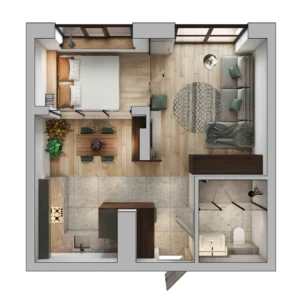
Micro-units and minimalist living are two growing trends in urban areas as people seek to lower their environmental impact and save money on housing. These housing units are living spaces less than 400 sq. ft. in size, that help enhance minimalist living through simplicity.
Imagine you are moving into a micro-unit apartment, excited about your new and minimalist lifestyle. But as soon as you start unpacking, you realize you have too much stuff. Your books, clothes, and other belongings barely fit in this tiny space, and you quickly feel overwhelmed and claustrophobic. But, the key to living comfortably in a micro-unit is decluttering and embracing minimalism. It means eliminating anything and everything you don’t use or need. It might be difficult to part with your things, but creating a more spacious and serene living environment is important.
This blog discusses what a micro-apartment is, its pros and cons, and the benefits of buying a micro-apartment as an investment.
What is a Micro Apartment?
By definition, micro-apartments or micro-units are small, one-room living spaces that offer all the same amenities as a one-bedroom apartment (a kitchen, bathroom, etc.) but within the smaller square footage ranging from 200 to 400 sq. ft. Micro-apartments, due to their limited size, look exactly as they sound—tiny, space-saving units and are smaller than most studio apartments.
They are often built with space-saving features such as foldable furniture, hidden appliances, and built-in storage. These housing units are becoming increasingly popular in urban areas, where land and housing costs are high.
Who Lives in Micro-apartments?
Single people and young couples typically inhabit micro-apartments. They are popular among the people who are downsizing from larger homes to apartments. These apartments are often located in urban areas, attracting people who want to live near the transport, shop, or restaurants.
Do you know why millennials like these tiny apartments? Here are a few reasons:
- They haven’t accumulated much “stuff” and don’t need much space.
- They are usually delaying marriage compared to previous generations, so they are still single.
- Millennials would rather prefer to use their money for travel and other forms of entertainment.
- Typically, they haven’t accumulated enough wealth to purchase a permanent home.
- Most millennials are making less income than previous generations in addition to trying to repay student loans.
- Micro-apartments are in proximity to work and school.
- Roommates aren’t required, so tenants can finally live alone, maybe for the first time in their lives.
Pros of Micro-units
Micro-units are becoming popular due to several benefits offered by them. Some of the pros are mentioned below:
1. Affordability
These units are typically more affordable than traditional apartments or homes, especially in high-cost urban areas.
2. Location
The micro-units are often located in desirable neighborhoods and close to public transportation, shops, and restaurants.
3. Simplicity
Living in a micro-apartment requires you to declutter and downsize, which can be a rewarding and less stressful way to live.
4. Environmental Impact
These micro-units have a lower environmental impact than larger homes. They require less energy to heat and cool and produce less waste.
5. Community
Several micro-unit buildings have built-in communal living aspects, such as kitchens, gathering spaces, and work environments. It can help build a sense of community among residents.
Cons of Micro-units
Micro-units have some potential drawbacks that must be considered before moving into one:
1. Small Size
Micro-units can feel claustrophobic, especially for people who are used to living in larger spaces.
2. Lack of Privacy
Usually, these tiny apartments are built near each other, and sound can easily travel through floors and walls. It can be problematic for people who need quiet surroundings to work or sleep.
3. Limited Storage Space
These units often have a limited storage space, which makes it difficult to keep everything in an organized way.
4. Isolation
Living in small spaces can be isolating, especially for people living alone.
5. Lack of Amenities
Most micro-unit buildings do not offer the same amenities as traditional apartments, such as pools, gym, laundry, etc.
Overall, micro-units can be a good option for people looking for an affordable and efficient place to live. Still, it is important to be aware of the potential drawbacks before deciding.
Features That Make Micro-apartments Feel Larger
Although micro-apartments are small by design, certain architectural features can make them feel much larger. When moving to a micro-apartment, keep an eye out for these features:
1. High Ceilings
High ceilings are one of the best features that can make a micro-apartment feel larger. It creates a sense of airiness and spaciousness, even in a small space.
2. Natural Light
Large windows facing the sun will brighten your apartment and make it feel more spacious.
3. Outdoor Space
A balcony can add extra living space and make your apartment feel more connected to the outdoors.
4. Built-in Storage
Micro-apartments use vertical spaces to store your belongings without taking up valuable floor space.
Examples of Micro-apartment Floor Plans
There are many great micro-apartment floor plans to choose from in California. A few examples are:
1. The Parker – Los Angeles

This micro-apartment building offers a variety of floor plans, including studios and one-bedroom, all under 400 sq. ft. These apartments feature high-end finishes and appliances, as well as amenities, such as a rooftop pool and fitness center.
2. The Hub – San Francisco

This micro-apartment building offers a variety of studios and one-bedrooms, all under 300 sq. ft. These apartments feature innovative space-saving features, along with several amenities like co-working space, fitness center, etc.
3. The Flats on Broadway – Oakland

This micro-apartment building offers a variety of studios and one-bedrooms, all under 400 sq. ft. These micro-apartments are designed to be both stylish and functional.
Benefits of Investing in Micro-apartments
There are several benefits to investing in micro-apartments, including:
1. High Demand
Micro-apartments are in high demand in many urban areas as they are affordable and convenient. It means the investors can expect to have a steady stream of renters and can charge higher rents for larger apartments.
2. Low Maintenance Costs
These apartments are typically smaller and less complex than larger apartments. It means they have lower maintenance and repair costs. It can save investors money in the long run.
3. High ROI
The micro-apartments often have a higher ROI than larger apartments, as they are less expensive to purchase and operate. It is an attractive feature of this investment.
4. Lower Risk
Micro-apartments are usually less risky to invest in than larger apartments. These apartments are higher in demand but require less maintenance costs. It means investors are less likely to lose on their investments.
5. Tax Benefits
Micro-apartment investors may be eligible for several tax benefits, such as depreciation and deductions for mortgage interest and property taxes.
The Bottom Line
If investing in micro-apartments appeals to you, ensure that you do your research before buying one. Investors and developers cannot just start building these micro-apartments everywhere as there are rules and zoning apartments that might prohibit making small apartments or micro-units. To help you decide whether purchasing a micro-apartment is a viable investment, speak with Beach Front Property Management Inc. professionals to get an expert opinion on what might be needed to make such an investment.
Check out our blog posts below for related content!
How to Maximize Space in a Small Apartment: Creative Solutions for Efficient Living
Learn more about how we can help. Customized solutions for large portfolios!
